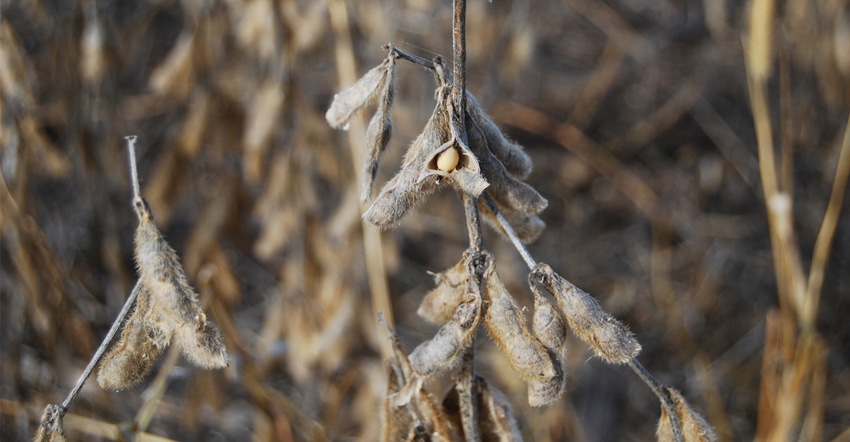March 28, 2019

Flooded fields and wet soil conditions in the fall meant some soybean fields were not harvested. And they aren’t going to be harvested this spring.
Also, some fields experienced shattering or a hailstorm last fall, and soybean seed was knocked from the plants and thus not harvested. When the grain is not harvested, nitrogen, phosphorus and potassium return to the soil in the soybean grain. Those nutrients can be accounted for when planning fertilizer and manure applications for the next crop in that field.
So, how do you figure how much to adjust your commercial fertilizer application or manure application rate in these fields? First, an estimate of the number of soybean bushels per acre lost is needed to approximate the amount of nutrient return to the soil, says John Sawyer, Iowa State University Extension soil fertility specialist. He offers the following information, explaining how to make the necessary adjustments in N-P-K fertilizer or manure nutrient applications for the corn crop to be planted this spring.
Calculation for P, K contribution
For P and K, the calculation is straightforward. Either multiply the estimated bushels of beans returned to the field times the bushel equivalent content for P2O5 and K2O (for soybeans, 0.72 pound P2O5 per bushel and 1.20 pounds K2O per bushel at 13% grain moisture). Or if the loss was significant or the was crop not harvested, simply assume that the fertilizer or manure P and K applied before planting were never removed from the soil.
With both approaches, the P and K returned to the soil in soybean grain will be available for future crop use. Because the soybean crop residue was not affected, there would be no difference in that source of nutrients from a normal harvest.
Calculating N contribution
It is expected that the usual “soybean rotation N effect” for the soybean-corn crop rotation will not change. That is, the maximum return to nitrogen (MRTN) rate provided by the Corn Nitrogen Rate Calculator for corn following soybeans in the crop rotation will be an appropriate initial starting point for an application rate.
However, an estimate is needed of the additional N that will be supplied by the soybean seed, which will be a deduction from the MRTN rate. At harvest, 63% of aboveground soybean plant N is contained in the soybean seed. In soybean seed, the N content (protein) varies, but 3.1 pounds N per bushel is a reasonable value. For example, a soybean seed yield of 60 bushels per acre would contain about 186 pounds N per acre.
How much N for corn?
You should think of the soybean grain lost to the soil as fertilization with an organic N form. Thus, an estimate is also needed regarding conversion of the seed N to crop-available inorganic N (ammonium and nitrate). Not all the seed N will be available the first year. Although it is not known exactly what the availability will be, a study of corn N response in fields with hailed-out soybean seed provides some guidance.
In a 2002-03 study where soybean seed was hailed out at harvesttime in fall 2002 (estimated 35 to 45 bushels per acre soybean grain yield on the ground), the next-year corn crop had an economic optimum N rate at 50 pounds N per acre compared to 120 pounds N per acre where the soybean crop had been harvested (corn yield about 220 bushels per acre).
That fertilizer N application requirement indicates a first-year N availability of approximately 60%. The Late-Spring Soil Nitrate Test (LSNT) values were higher where the soybean seed was hailed out, but not up to the critical test level.
Will N availability to plants be delayed?
These study results show N will become crop-available from soybean seed. Soil sampling in corn for the LSNT, or crop N stress sensing, can help confirm the corn N fertilization need. The LSNT results may be lower than expected due to seed N mineralization later in the season after sampling. Creating an “N-rich” or “non-limiting” N reference strip in the field or multiple non-limiting small areas can provide a comparison of N response.
In high yield-loss situations, it is possible that the crop rotation and soybean seed could supply all or nearly all of a corn crop's N need. In those instances, a suggested management practice would be to still apply a small amount of N (15 to 30 pounds N per acre as starter or weed-and-feed application) before or at planting to offset any early-season delay in N availability or lower-than-expected N supply from the soybean seed.
Tillage to break down seed
If the soybean seed germinated in the fall, it is unlikely there would be an impact on mineralization of N from the seed, but if there is any impact, it would increase the decomposition of the organic seed materials and enhance N release. It is unlikely that N will volatilize from the decomposing soybean seed, nor would tillage be needed to speed decomposition for seed on the ground (but it could for grain on standing plants).
Given soil erosion concerns related to tilling soybean stubble, it would be better to leave the fields alone until planting time in cropping systems where tillage is used. No-till systems will be more variable in N supply, and seed on standing plants will decompose differently (likely more slowly) than seeds and plants laying on or in the soil.
About the Author(s)
You May Also Like






